Affiliate disclosure: This post may contain affiliate links. Please see our Privacy Policy.
Comfrey has been used medicinally for thousands of years to reduce pain and promote healing. Modern peer-reviewed studies are finding that topical comfrey preparations, such as comfrey salve and comfrey cream, are incredibly effective herbal pain relievers.
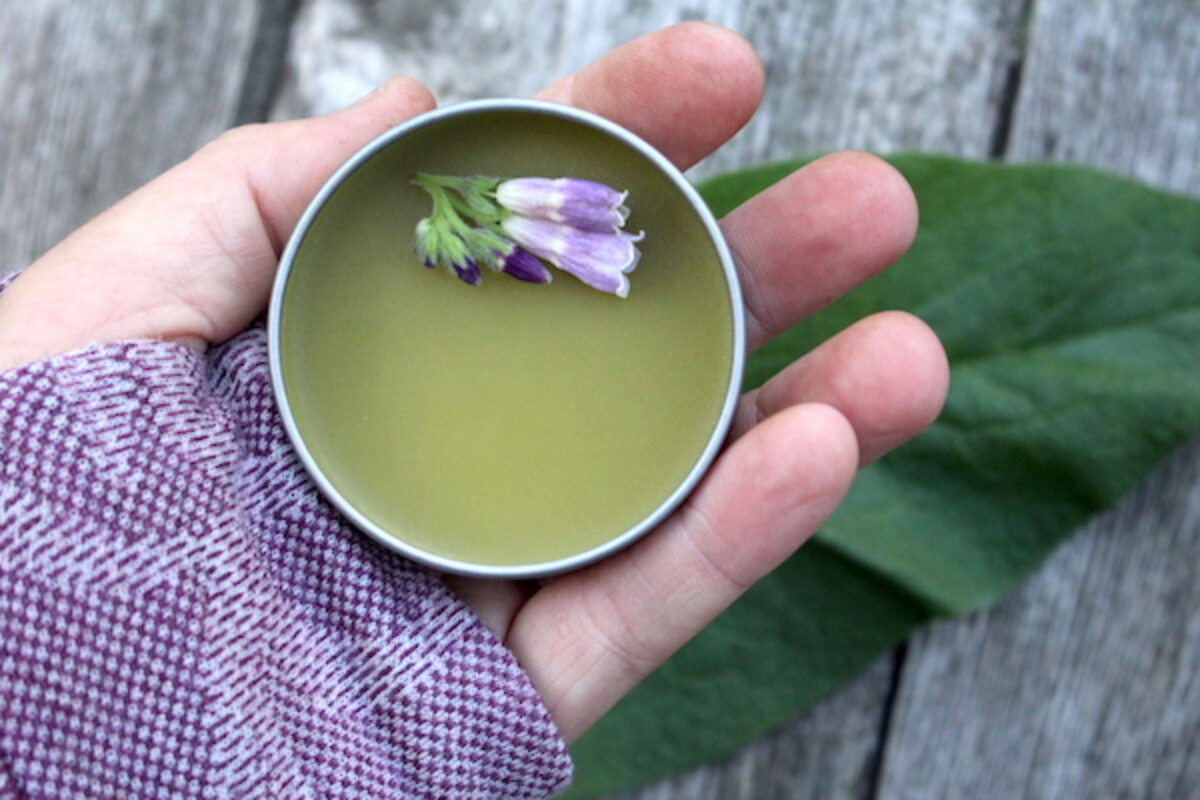
Common comfrey (Symphytum officianale) and Russian Comfrey (S. uplandicum) are fast-growing leafy plants that are considered invasive in some areas. They spread rapidly, and are incredibly difficult to control because new plants can sprout from even tiny sections of root left in the soil.
They’re popular in permaculture gardening circles because of their ability to pull micro-nutrients from deep in the soil, and the tops are cut and applied in a number of ways as soil amendments.
Whether or not it’s a good idea to plant comfrey in your garden is up for debate, and you’ll need to cut it several times a season to keep it under control. That just means you’ll have plenty of potent medicine to harvest (and a great source of nutrient-rich mulch).
If you don’t have comfrey growing nearby, you can still make comfrey salve with either dried comfrey leaf or comfrey root, both of which can be purchased online. If you’re just hoping to find a ready-made salve and skip the DIY portion, I’d suggest checking on Etsy for small-scale cottage industry salve producers.
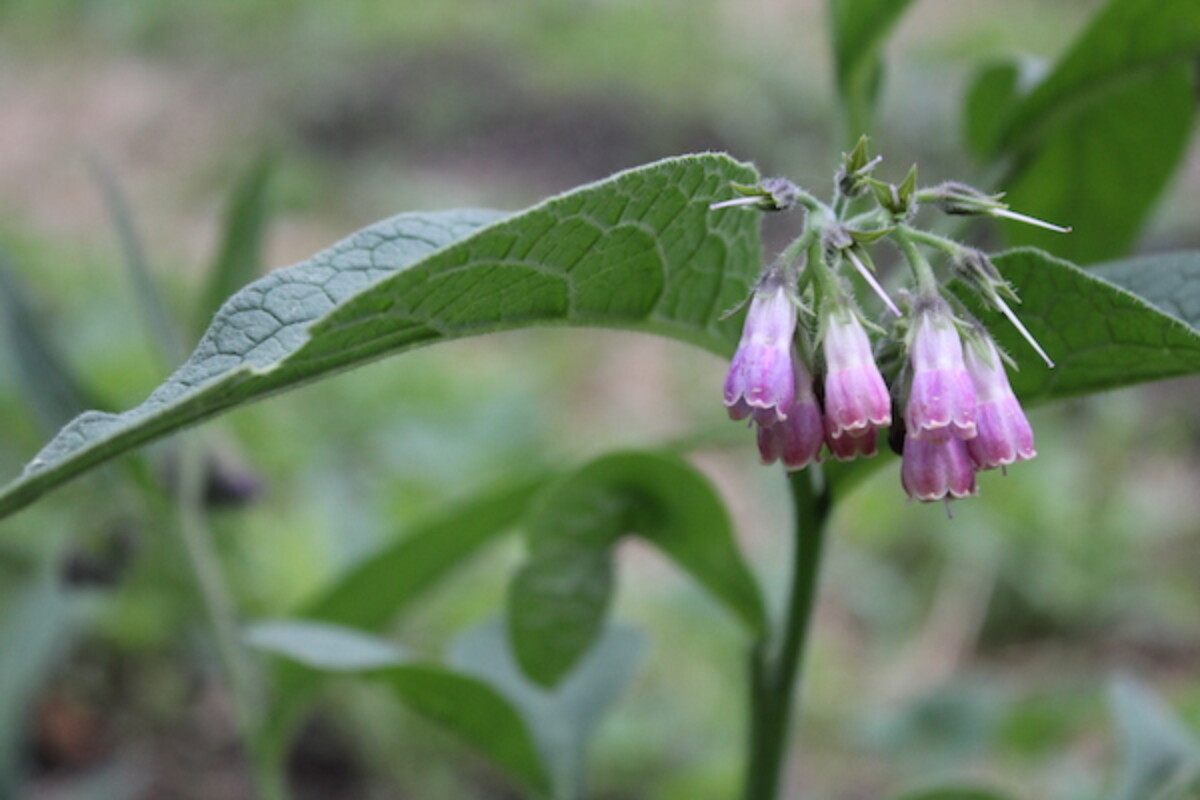
Comfrey’s medicinal benefits are well known, and even if you choose not to grow it for practical reasons, it’s easy enough to purchase dried comfrey leaves or dried roots for herbal remedies (either can be used to make comfrey salve).
I use comfrey salve to treat my chronic low back pain, brought long summer days in the garden and winters hauling a heavy chainsaw around our woodland homestead cutting firewood.
While historically comfrey was taken internally for all manner of issues (including broken bones), it’s now known to be potentially damaging to the liver when consumed, and it’s best avoided. Topically though, comfrey is still in common use for pain relief and minor wounds.

(Always consult your doctor or a clinical herbalist before trying any new herbal remedy, as there’s always the possibility of unintended consequences, allergic reaction, or interactions with other medication. If you’re harvesting wild plant material, make sure you’re 100% confident in your identification and consult multiple sources for your ID. The following is based on my research and experience, but I don’t claim to have any certifications that would qualify me to advise you on your health. Please do your own research and always verify with multiple reputable sources.)
Benefits of Comfrey
Comfrey has been shown to reduce inflammation, reduce pain, and speed skin healing. It contains allantoin, a substance believed to promote healing by stimulating the growth of new cells.
Since it’s potentially toxic taken internally, these days comfrey is only used topically as a herbal salve or cream. Salves are easy to make and require minimal ingredients and equipment.
They’re also simple to use and can store for extended periods (1-2 years) without spoiling or losing potency. Comfrey cream and comfrey ointments also work well, and I’ll cover those later on.
Herbalists commonly recommend comfrey salves for sprains, strains, muscle pain, arthritis, bruises, and fractures.
But what does the science say?
Back Pain
The British Journal of Sports Medicine found that topical comfrey creams were incredibly effective at treating acute back pain. The study found that pain intensity decreased by 95.2% in the comfrey treated group, as opposed to 37.8% in the placebo group.
Most notably, the study found that comfrey is fast-acting, with relief experienced in about an hour!
The study concluded that “comfrey root extract showed a remarkably potent and clinically relevant effect in reducing acute back pain.”
Osteoarthritis
Multiple studies have shown that comfrey salves reduced pain and increased mobility in patients with osteoarthritis.
A study on osteoarthritis of the knee found that pain was reduced by more than 50% with comfrey creams, as opposed to 10-15% with placebo during a 3 week study period. Another similar study confirms these results (but also noted a few cases of a topical skin reaction to comfrey.)
While pain is reduced and mobility increased, yet another study went further and found that though the symptoms are reversed, the actual measurable inflammation and cartilage breakdown within the knee are not improved.
It seems that comfrey may reduce osteoarthritis pain and symptoms, but it’s not actually healing the underlying condition.
Sprains
Comfrey’s pain-relieving effects are helpful in treating the pain associated with joint sprains, and one study found that topical applications of comfrey are as effective as synthetic prescription pain-relieving gels. The study only addressed pain symptoms, however, and didn’t investigate whether comfrey creams helped to heal sprains.
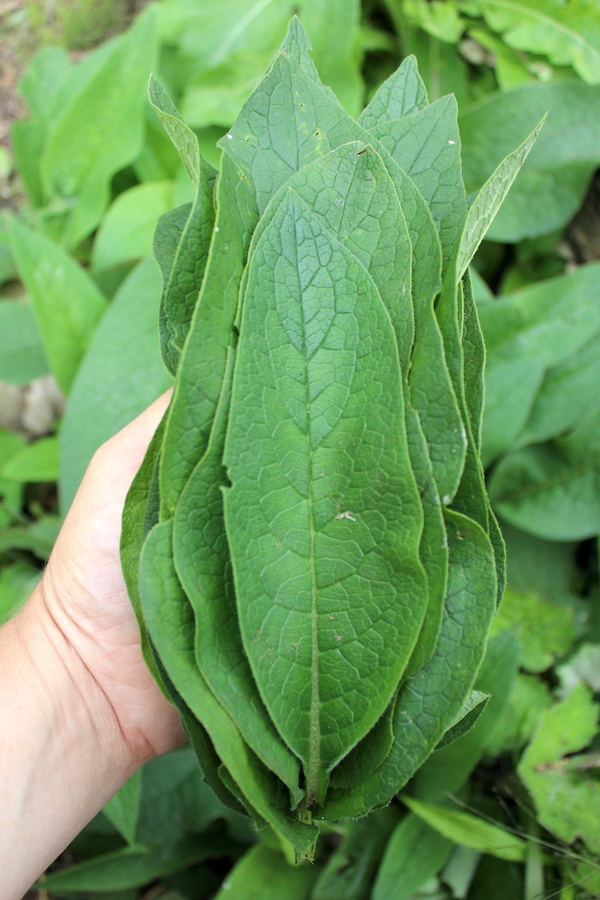
Precautions for Use
Do not ingest comfrey! Comfrey isn’t for internal use and you should never ingest comfrey in any form. Older herbals recommended consuming comfrey to help with bone healing, but that’s no longer recommended due to the risk of liver poisoning (and death in high enough doses).
Comfrey varies in constituents based on the strain, and it’s possible that the strains of comfrey consumed in medieval Europe were kept specifically for internal use. Those strains are no longer kept (or if they are, their ID and use aren’t certain). These days it’s impossible to know if some strains are safer than others without individual chemical analysis, and even then it’s not worth the risk.
Skin reactions have been reported in a small number of people in the clinical trials I mention, and there’s always the possibility of an allergy. I’d suggest doing a small patch test before using too much for the first time, just to be sure that you don’t have a reaction. That goes for any topical herbal remedy, not just comfrey salve.
Comfrey is for external use only, which is why a comfrey salve is an excellent way to use it.
Making Comfrey Salve
Making a homemade comfrey salve follows the same process as making any other herbal salve. It all starts with making a herbal infused oil.
The infused oil is then thickened with melted beeswax before pouring into containers to harden.
Making an Infused Oil
Infused oils are best made with dried herbs and a bit of patience. The dried herb material won’t cause the oil to go rancid while infusing, as opposed to wet herb material.
Fill a jar about 2/3rds full with dried comfrey leaves or dried comfrey root. Cover with a neutral oil, such as olive oil, and allow the herbs to infuse into the oil for about 4-6 weeks before straining.
If you’re using fresh herbs, or trying to make comfrey salve in less than 4-6 weeks, try the heat infusion method. Start by chopping the fresh herbs to expose more surface area.
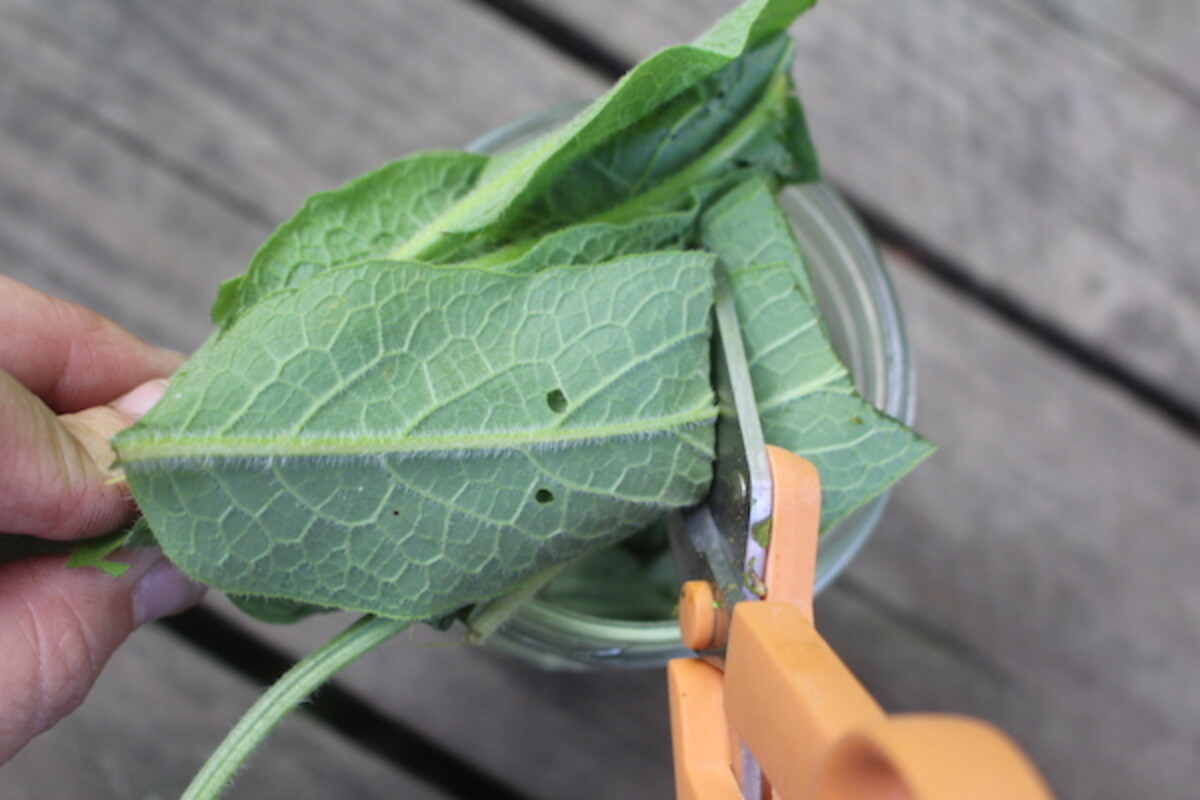
Place the fresh or dried herbs in a jar, cover with oil and then place the jar into a double boiler. Gently heat the water in a double boiler, warming the oil, but keeping it under 140 degrees. It’s important that the herbs infuse (not deep fry).
A crockpot set to “keep warm” works well for this, but a small pot of water on very low heat also works.
Allow the fresh or dried herbs to infuse in the double boiler for about 24 hours before straining and continuing with the process.
(Note: If using fresh herbs, make sure the jar is open during the infusion process so that moisture can evaporate from the herb material)
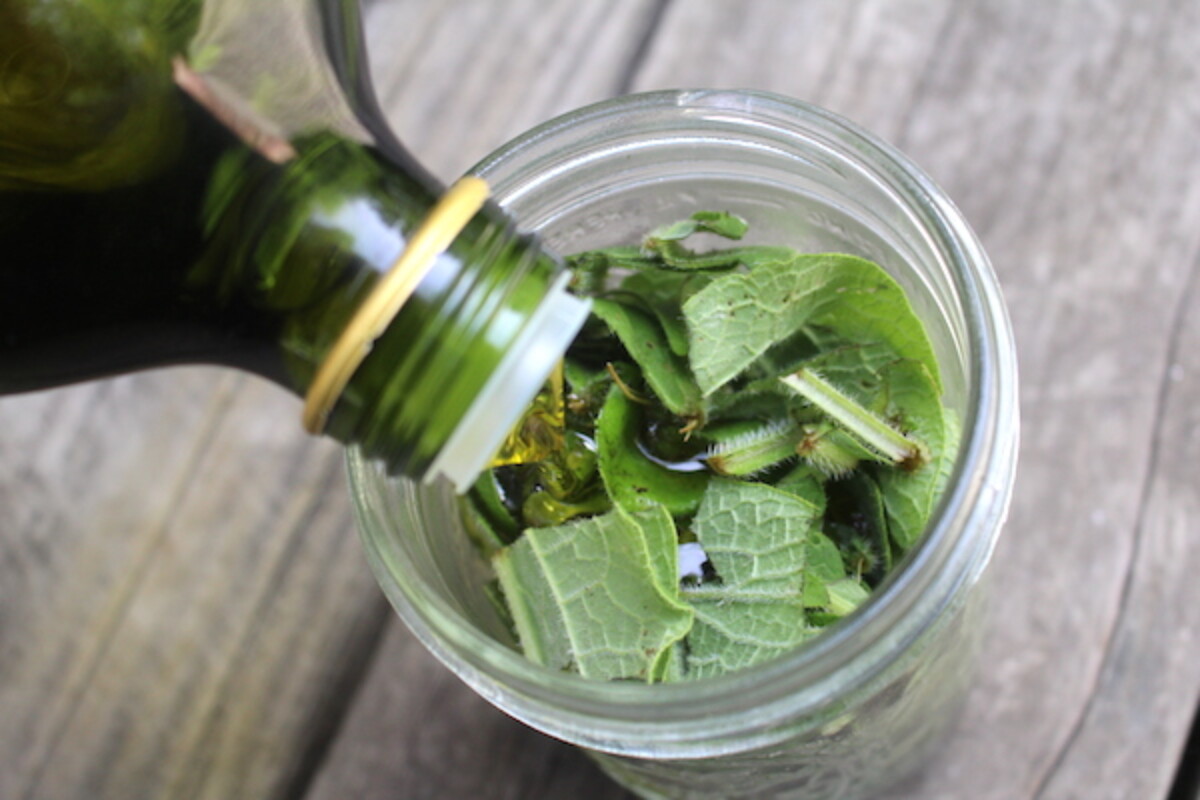
Making a Herbal Salve
Once you have a comfrey infused oil, it’s simple to thicken it into a herbal salve.
Salve recipes vary, but I like the consistency when I use a 1 to 8 ratio of oil to beeswax (by weight). I weigh out 8 ounces of herb-infused oil, which is about what you end up with if you pack a wide-mouth pint mason jar with comfrey and cover it with oil.
Once it’s strained out, you should have about 8 ounces of oil. Next, weigh out 1 ounce of beeswax. Using easy melting beeswax pistils makes this process easy, but you can also chop some off a large block of beeswax.
Put the oil and beeswax in a heat-safe bowl or double boiler bowl, and gently melt it over a pot of simmering water (basically, in a double boiler). Once melted, pour the salves into jars or salve tins.
I’m using 2-ounce salve tins, which hold ever so slightly more than 2 ounces. I’m able to get 4 tins of comfrey salve from a single batch.
Allow the salves to cool and firm up for a few hours before using them.
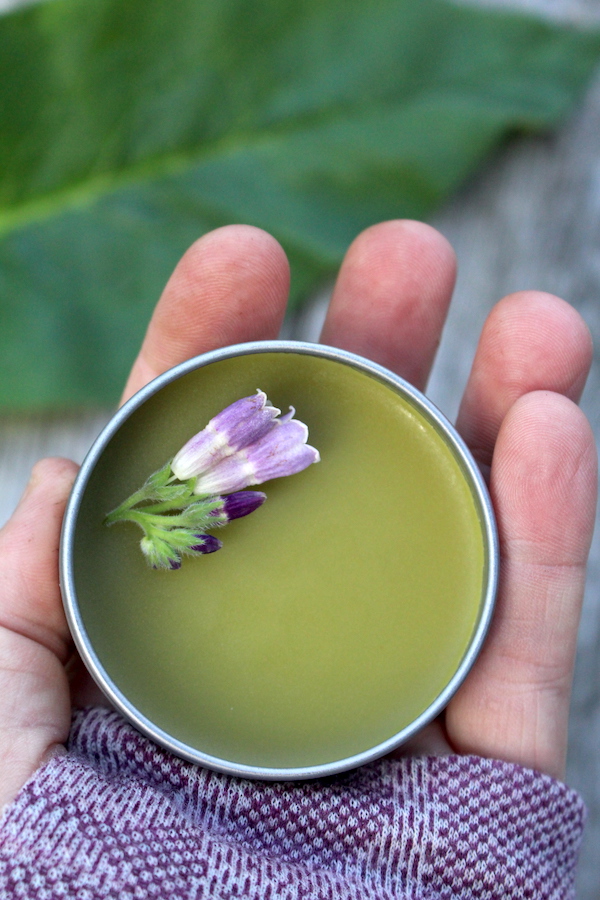
Where to Buy Comfrey Salve
Homemade comfrey salve has its benefits…you know what’s in it, how the comfrey was grown (if you grew it) and it can save money compared to buying prepared comfrey salves. That said, the downside is that the dosage can be variable.
Different strains of comfrey have different medicinal potencies. There are a few named varieties that are grown for their high concentrations of healing compounds, and it’s hard to know the potency of comfrey harvested from your yard.
Most studies using topical comfrey applications used a standardized comfrey salve with 35% comfrey extract, while the dosage of homemade comfrey salve is unknown. I looked for comfrey cream and salves with a standardized dosage and I actually couldn’t find any, not a single one! (If you find one, please let me know in the comments).
I did, however, find two commercially available comfrey preparations, one cream, and one salve. I’ll warn you though, they’re expensive, about $10 an ounce…
- Traumaplant Comfrey Cream ~ Made into an easy-to-apply cream in a tube.
- Herb Pharm Salve ~ Not strictly comfrey, but also contains St. John’s Wort, Calendula, Chickweed, Mullein, Plantain, and Rosemary.
For me, I’m less concerned with standardized dosage than I am with results. If my homemade comfrey salve gets the job done, the dosage is just another number.
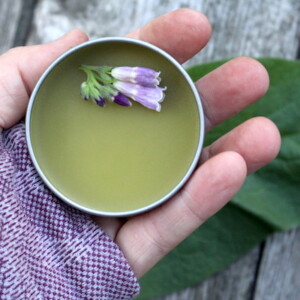
Comfrey Salve
Ingredients
- 1 1/2 cup fresh comfrey leaves or 1 cup dried comfrey leaves or roots
- Olive Oil to Fill about 10 ounces
- 1 ounce beeswax
Instructions
- Place comfrey in a pint mason jar and cover with a carrier oil (like olive oil). Be sure to cover the herb material by at least an inch, and stir to remove air bubbles.
- For the fast infusion method, which is required for fresh herbs, place the jar in a double boiler or crockpot with water. Turn it on very low, and gently heat the mixture keeping it under 140 degrees. Allow the herbs to infuse in the warm oil for 24 hours before straining. (Can be used with fresh or dried herbs.)
- For the slower infusion method (only with dried herbs), allow the herbs to infuse at room temperature for 2-6 weeks before straining.
- Measure the strained herb-infused oil. You should have roughly 8 ounces of oil. For every 8 ounces of oil, add 1-ounce beeswax (by weight).
- Place the herb-infused oil and beeswax into a heatproof bowl and warm gently over a double boiler. Stir to combine and once melted, remove from heat.
- Pour the comfrey salve into salve tins or small jars and allow the mixture to cool for a few hours before using.
Notes
More Homemade Herbal Remedies
Looking to stock your home apothecary with more than just comfrey salve? Here are a few more of my favorite homemade herbal remedies:
- Arnica Oil and Salve
- Homemade Herbal Shampoo
- Winter Immune Support Tea Blend
- Reishi Tincture
- Echinacea Tincture
- Elderberry Oxymel
- Willow Bark Aspirin
Disclaimer on Homemade Herbal Remedies
I’ve been foraging wild medicines and treating my family with herbal remedies for the past 20 years, but I’m self-taught. Be aware that I am not a clinical herbalist, and this is based on my own research and personal experience using medicinal plants. I do not claim to have the experience that’d qualify me to advise you on your health, and I’m only providing this as a reference to encourage a broader interest in medicinal plants.
Please use this as a jumping-off point, but always do your own research and verify anything you read with multiple sources.
It’s always possible to have an adverse reaction to any medicinal herb, and plenty of people are allergic to even gentle herbs like chamomile. Always consult your doctor or a certified herbalist before trying any new medicinal plant. Often, they can have unintended reactions in combination with other herbs and supplements, and many herbs have side effects even when they are effective for their intended purpose.
If you are seriously interested in herbal medicine, I’d suggest investing in a course in herbal medicine, and I’d recommend any of the online courses put out by the Herbal Academy of New England. Specifically, the introduction to herbal medicine course and the family herbalist group of courses.
They also have a mushroom course, covering both medicinal and edible mushrooms, and a Botany and Wildcrafting Course. I’ve taken both and they’re informative, inspiring, and artfully presented.
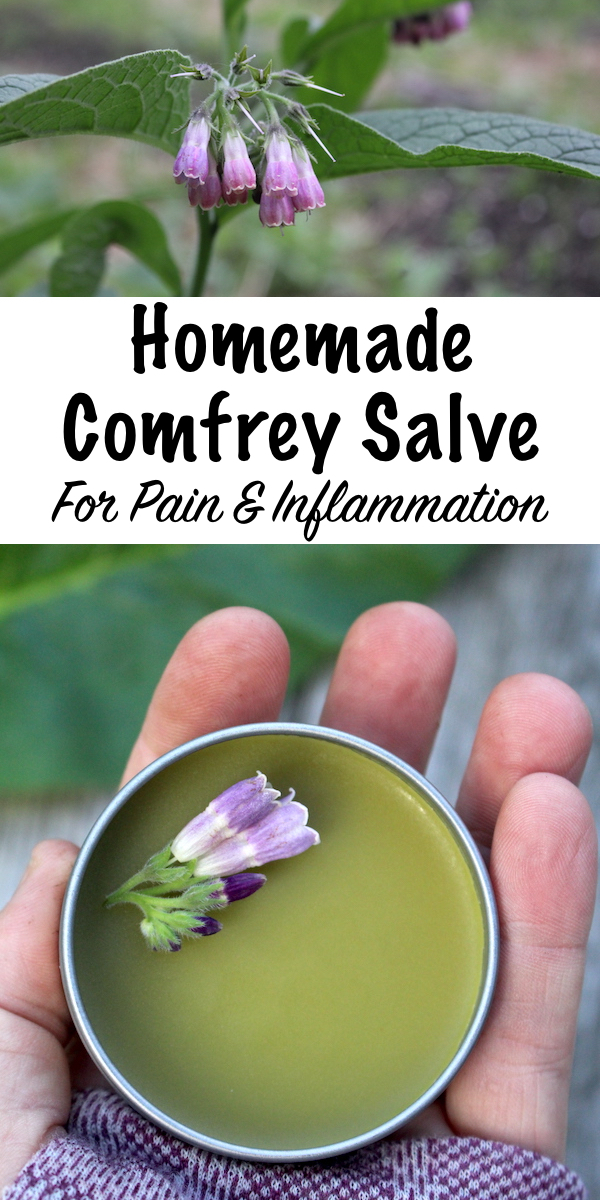


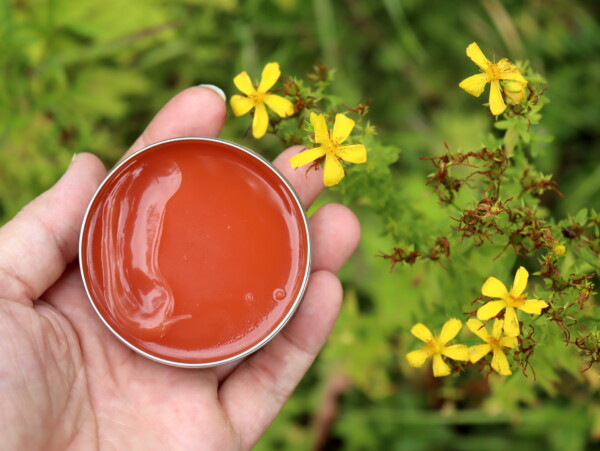
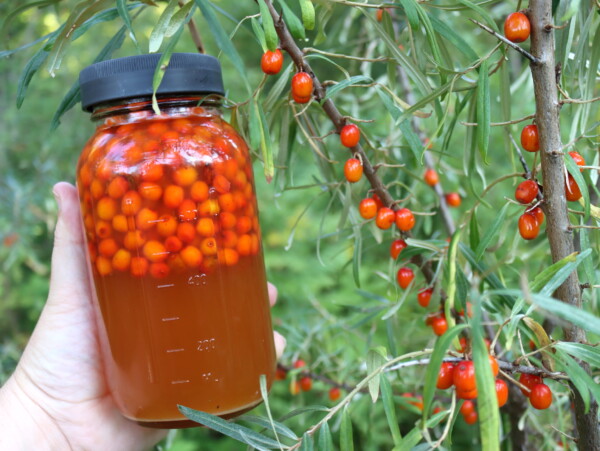










I have been using your recipe and it is great! Normally I have done it at 6 week mark for best potency. Recently I have been ill and was unable to make it. It is still in the oil and it is probably 2 months or more. Is OK the make the salve still? Thank you for your reply in advance.
Yes, that’s perfectly fine. I often end up with mine going a bit longer, simply because life gets in the way (illness or otherwise). Salves are really forgiving that way, and extra time isn’t an issue. Hope you’re feeling better!
I made some in my crockpot on low but maybe they overheated? I better find some more…
Great articles on using herbs Ashley.
I would like to share that Comfrey is not a herb to be scared of and I feel quite sad that a fallacy has perpetuated to the degree that it is common for people to feel cautious about it.
The story where that originated has more holes in it than a sieve.
There was a fellow who died in 1983. However… the plant in question was NOT COMFREY. There was no plant identification done.
And even if there was a possibility, it could not be so as it was winter in the highlands in Australia (and as we know comfrey does not grow above ground in winter.. especially not in the snow!).
There was a court case where my teacher in Herbal Medicine Dorothy Hall fronted to defend “A Herbalist’s most potent remedy” and our use of Comfrey in internal medicine, in 1984. This court case was funded and backed by members of the pharmaceutical industry and she relayed their less-than-pleasant comments to her in the corridor about the agenda they had in mind (comfrey was just the first herb they were targeting) to us in class.
As a herbalist, I cannot legally add it to a herbal mixture but I have no qualms about using it myself for improved (3x faster and 3x more accurate) healing.
I just thought I would share as it is a beautiful herb that has so much to give.
That’s fantastic, thx for sharing. I, too, was shaking my head over the ‘not to ingest’ statements – phooey! Comfrey tea is supposedly quite helpful, but apparently doesn’t taste that great. Who cares, if it works. If memory serves, it’s also called knit bone and is remarkably healing for > broken bones.
How was it used, back in the days when herbs where our medicine(s)? (before the evil *ockefeller demonized natural healing and natural physicians) That’s what we need to re-discover.
My mom had a huge comfrey plant in the backyard and the bees were over the moon for it. That alone is reason to plant one!
1 milligram of allantoin per gram of comfrey, potentially slightly less with oil infusion/type of process used for drying/infusing.
Hi I was wondering if you could do the quick crockpot infusion with dried roots or leaves ?? I was given some very small baby comfrey plants so they are not ready to use. Thank you
Yes, you can definitely use dried roots and leaves.
Hi Ashley,
I need your help. I just made my first batch of comfrey infused castor oil using the heat infusion method. I was careful to not heat it over 140° as to not degrade the medicinal properties. I intended on making a salve with it but the recipe I followed recommended a 4:1 ratio for infused oil to beeswax. It turned out more like a balm. It was too firm, I couldn’t even push my finger tip into it and created too much drag on the skin. I read that it could be melted down again to add a thinner oil to it such as grapeseed oil which is what I had on hand. I set my crock pot on high just to spead up the process a bit to get it up to about 125° or so, intending on turning the it back down to the warming setting but I forgot. It did not heat very long, about 45 mins total starting out with the crock being cold but when I checked the oil temp my heat thermometer it read 170°. I feel pretty awful about it as I am afraid that I have ruined it. How would I be able to tell if I wrecked all my hard work?
I wouldn’t worry too much about it. Those temperatures are a guideline and I know lots of herbalists that heat them higher than 140. It may not have as much medicine but it will still be a really good salve.
Thanks but your oil to beeswax ratio is flipped above. You say 8 to 1 oil to wax but your words above say the reverse. Can’t wait for spring comfrey! 🙂
Yes it should be 8 parts oil and 1 part beeswax.
I love making comfrey salve! I started growing the plants from seed many years ago to support my soil so I could grow more nutrient rich food. I then learned of all the other benefits and started making the salve.
That’s great. Thanks for sharing.
Thank you so much for this recipe. Not sure if this will be seen but I have a question regarding the temperature minimum. I infused the oil with leaf matter below 140 degrees as instructed. However, beeswax has a melting point of 144-150 so in order to melt the beeswax into the mixture, the temp must rise higher than the max temp recommended. I can’t see that this was mentioned anywhere
You want to keep the oil under 140 degrees while the herbs are infusing. Once the oil is done, you will strain the herbs out. You can then mix the oil and the beeswax together and then heat it until the beeswax is melted.
Can I mixed some dried lemon verbena leaves in with the dried comfrey? I have both plants in my garden. Do you know if lemon verbena’s properties would enhance or support comfrey’s? I’m thinking it would smell great!
I don’t have any personal experience regarding the benefits of lemon verbena but it’s worth trying.
Wondering how much powder you would use versus leaves to make a salve?
Try 1 to 2 tablespoons for a 1/2 cup of oil.
Great article! I suffer from chronic neck and back pain and am always on the hunt for remedies. I’m new to making salves and body butters, and just bought comfrey essential oil. Can I use that, and if so how much? Thank you!
I’m sure you can use it but unfortunately I don’t have any experience using the essential oil. The manufacturer of the essential oil may have some more information about the safe usage rate for a salve. You could also try eocalc.com and see if they have any information.